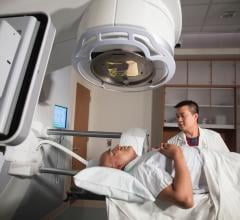July 29, 2008 - One of the pioneering machines in image-guided radiation therapy (IGRT) has begun to mature, with over 1,000 treatments at one Oklahoma hospital alone.
The hospital's staff has generated best-fit parameters from this voluminous data set.
In 2003, the TomoTherapy Hi-Art treatment system became one of the first to combine intensity modulated radiation therapy with CT scanning to ensure that the patient is well-positioned to receive the highly-sculpted beam energy. One of the specifications that makes the TomoTherapy hardware unique is that radiation is applied by a constantly rotating beam through which the patient advances on a slow-moving couch. The result is a helically-shaped radiation delivery.
Even though the TomoTherapy system is more automated than traditional treatment plans, the user must choose parameters such as beam size, delivery modulation, gantry rotation speed, and how fast the couch moves. As the technology is still fairly new, not many medical physicists are very familiar yet with what values to use.
But Dr. Allen Movahed (allen.movahed@ctca-hope.com) and his fellow staff are highly experienced with TomoTherapy planning parameters, seeing as the Cancer Treatment Center in Tulsa, OK, where they work has two of the machines. Ninety percent of the hospital's 70 radiation treatments per day are performed on a TomoTherapy machine. Dr. Movahed says the reason is that the helical radiation delivery provides better tumor coverage and depending on the shape and location of the tumor even less time than other radiation therapy technologies.
Dr. Movahed and colleagues have compiled a list of best-fit parameters that draw from their own trial and error with the TomoTherapy machines.
The procedures covered include prostate, lungs, brain, liver, head & neck, breast, pelvis and pancreas.
For more information: www.aapm.org
Source: American Association of Physicists in Medicine


 June 07, 2022
June 07, 2022 








